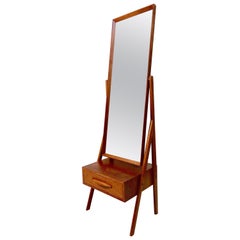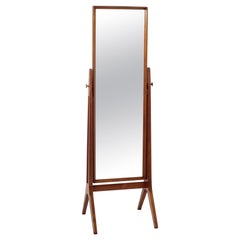Scandinavian Modern Cheval Mirror
Recent Sales
Mid-20th Century Danish Scandinavian Modern Floor Mirrors and Full-Lengt...
Teak
Mid-20th Century Swedish Scandinavian Modern Floor Mirrors and Full-Leng...
Brass
Vintage 1960s Danish Scandinavian Modern Floor Mirrors and Full-Length M...
Teak
Vintage 1960s Danish Scandinavian Modern Floor Mirrors and Full-Length M...
Wenge, Teak, Mirror
Mid-20th Century Danish Scandinavian Modern Floor Mirrors and Full-Lengt...
Mirror, Hardwood
Vintage 1970s Danish Scandinavian Modern Floor Mirrors and Full-Length M...
Teak, Mirror
Vintage 1970s Danish Scandinavian Modern Floor Mirrors and Full-Length M...
Mirror, Teak
Vintage 1960s Danish Scandinavian Modern Floor Mirrors and Full-Length M...
Mirror, Teak
Vintage 1950s Danish Scandinavian Modern Floor Mirrors and Full-Length M...
Mirror, Teak
Vintage 1960s Danish Scandinavian Modern Floor Mirrors and Full-Length M...
Mirror, Rosewood
A Close Look at Scandinavian-modern Furniture
Scandinavian modernism is perhaps the warmest and most organic iteration of modernist design. The work of the designers associated with vintage Scandinavian modern furniture was founded on centuries-old beliefs in both quality craftsmanship and the ideal that beauty should enhance even the humblest accessories of daily life.
ORIGINS OF SCANDINAVIAN MODERN FURNITURE DESIGN
- Emerged in the 1930s
- Scandinavian design and Nordic design originated primarily in Denmark, Sweden, Finland, Iceland and Norway
- Introduced in the United States in mid-20th century
- Informed by the Bauhaus; influenced American mid-century modernism
CHARACTERISTICS OF SCANDINAVIAN MODERN FURNITURE DESIGN
- Bold, clean lines and simple, sturdy symmetries
- Use of natural materials — native woods such as pine, ash and beech
- Open, airy spaces
- Promotion of functionality
- Emphasis on craftsmanship; rooted in cabinetry profession and traditional construction techniques
- Minimal ornamentation (little to no embellishment)
- A neutral or light color palette owing to prominence of light woods
SCANDINAVIAN MODERN FURNITURE DESIGNERS TO KNOW
- Alvar Aalto
- Hans Wegner
- Kaare Klint
- Arne Jacobsen
- Greta Magnusson Grossman
- Finn Juhl
- Arne Vodder
- Verner Panton
ICONIC SCANDINAVIAN MODERN FURNITURE DESIGNS
VINTAGE SCANDINAVIAN MODERN FURNITURE ON 1STDIBS
The gentle, organic contours that are typical of Scandinavian design appear in the furnishings and decor created by Danish, Finnish and Swedish designers not as a stylistic gesture, but rather as a practical, ergonomic — and, as importantly, elegant — response to the human form.
Each nation produced exceptional talents in all areas of the applied arts, yet each had its forté. Sweden was home to Greta Magnusson Grossman and Bruno Mathsson — creators of the classic Grasshopper lighting series and Berlin daybed, respectively — but the country excelled most notably at ceramics. In the 1920s at the great Gustavsberg porcelain manufactory, Wilhelm Kåge introduced pieces in the Scandinavian style based on influences from folklore to Cubism; his skills were passed on to his versatile and inspired pupils Berndt Friberg and Stig Lindberg.
Likewise, Finland produced a truly ingenious Scandinavian modern furniture designer in the architect Alvar Aalto, a master at melding function and artistic form in works like the Paimio chair, created in collaboration with his first wife, Aino. Yet Finnish glassware was pre-eminent, crafted in expressive, sculptural designs by Tapio Wirkkala and Timo Sarpaneva.
The Danes excelled at chairs. Hans Wegner and Arne Jacobsen were exemplars of the country’s facility with wood, particularly teak.
Wegner created such iconic pieces as the Round chair and the Wishbone chair; Jacobsen — while the revolutionary architect and furniture innovator produced the best-selling plywood Ant chair — designed two classic upholstered pieces of the 1950s: the Swan chair and Egg chair. The list of great Danes could go on and on, including Finn Juhl, a stylistic maverick and maker of the bold Chieftain chair; Poul Kjaerholm, with his lean metal-and-rattan aesthetic; and Verner Panton, who introduced a vibrant Pop note into international design.
Today, decades after their heyday, the prolific, ever-evolving Scandinavian modernists continue to amaze and delight, and interior designers all over the world use their pieces to bring warmth to any given space.
On 1stDibs, you will note both instantly recognizable vintage Scandinavian modern chairs, sofas, rugs and tables — those that have earned iconic status over time — and many new discoveries.
Finding the Right Floor-mirrors-full-length-mirrors for You
Bringing antique and vintage floor mirrors and full-length mirrors into your home is a no-brainer. The right mirror in the bedroom, bathroom and by the door in your home’s entryway — for last-minute accessorizing, of course — can make all the difference.
However, knowing where to strategically place your mirror can help illuminate your interior design choices and add a glamorous accent to any room.
A large beveled floor mirror can add depth to a space — particularly if you’re working with small rooms. It can echo the contour lines of wall paneling and make a bedroom appear larger than it is. Both floor mirrors and full-length mirrors create a window-like effect, reflecting light and brightening the room. Hanging a large mirror opposite a window will flood a room with natural light and engender a feeling of spaciousness.
Consider the placement of a mirror in the room: Displaying vases, boxes and other decorative objects in front of a mirror reflects these items, drawing attention to a prized collection and emphasizing their visual qualities for dramatic effect.
A large antique wall mirror or celebrated iconic design such as Paul Evans’s Patchwork mirror or the flashy, sensuous Ultrafragola mirror created by Ettore Sottsass can be positioned as the focal point in a living room or dining room.
When your mirror isn’t the star of the show, it can be used to enhance a focal point. Hang abstract art — a grouping of paintings or drawings, perhaps — on the wall opposite the mirror to establish narrative character in a space and create an intriguing color pattern.
It is important to consider the size, shape and frame of a mirror. Most full-length mirrors have a traditional rectangular shape, but postmodern mirrors may offer more variety. For a mirror that makes a bold statement, Art Deco mirrors typically feature geometrically pronounced frames that stand out in a room.
Add light to your interiors while providing an artistic accent to any room. Browse the selection of antique and vintage floor mirrors and full-length mirrors on 1stDibs today.

